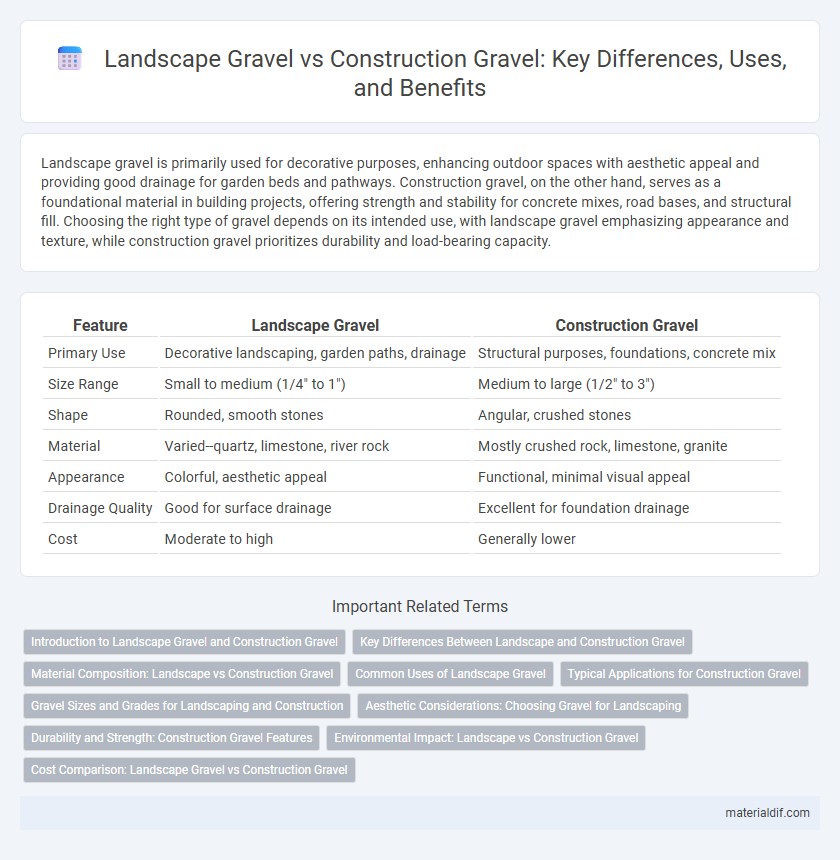Landscape gravel is primarily used for decorative purposes, enhancing outdoor spaces with aesthetic appeal and providing good drainage for garden beds and pathways. Construction gravel, on the other hand, serves as a foundational material in building projects, offering strength and stability for concrete mixes, road bases, and structural fill. Choosing the right type of gravel depends on its intended use, with landscape gravel emphasizing appearance and texture, while construction gravel prioritizes durability and load-bearing capacity.
Table of Comparison
| Feature | Landscape Gravel | Construction Gravel |
|---|---|---|
| Primary Use | Decorative landscaping, garden paths, drainage | Structural purposes, foundations, concrete mix |
| Size Range | Small to medium (1/4" to 1") | Medium to large (1/2" to 3") |
| Shape | Rounded, smooth stones | Angular, crushed stones |
| Material | Varied--quartz, limestone, river rock | Mostly crushed rock, limestone, granite |
| Appearance | Colorful, aesthetic appeal | Functional, minimal visual appeal |
| Drainage Quality | Good for surface drainage | Excellent for foundation drainage |
| Cost | Moderate to high | Generally lower |
Introduction to Landscape Gravel and Construction Gravel
Landscape gravel consists of small, decorative stones often used for pathways, garden beds, and aesthetic ground cover, enhancing outdoor spaces with texture and color. Construction gravel, typically larger and more angular, serves as a foundational material in concrete production, road base, and drainage systems due to its strength and stability. Understanding the distinct purposes and physical properties of landscape gravel versus construction gravel helps in selecting the right type for both functional and decorative outdoor projects.
Key Differences Between Landscape and Construction Gravel
Landscape gravel typically consists of smooth, decorative stones available in various colors and sizes, designed primarily for aesthetic appeal and surface drainage in gardens and pathways. Construction gravel, often referred to as crushed stone, is composed of angular, rough-textured rocks intended to provide structural support in foundations, concrete mixes, and road bases. The key differences lie in texture, size uniformity, and function, with landscape gravel emphasizing appearance and water flow, while construction gravel prioritizes stability and load-bearing capacity.
Material Composition: Landscape vs Construction Gravel
Landscape gravel typically consists of natural, rounded stones like river rock, pea gravel, or crushed granite, chosen for their aesthetic appeal and smooth texture. Construction gravel, on the other hand, is composed primarily of crushed stone or recycled concrete materials with angular edges, designed for compaction and stability in building foundations. The material composition of landscape gravel emphasizes visual texture and drainage, whereas construction gravel prioritizes strength and load-bearing capacity.
Common Uses of Landscape Gravel
Landscape gravel is primarily used for decorative applications such as garden paths, walkways, and mulch alternatives that improve soil drainage and prevent weed growth. It enhances aesthetic appeal in landscaping projects by providing texture and color contrast around plants and outdoor living spaces. Unlike construction gravel, landscape gravel is not typically used for structural support but focuses on functional and visual enhancement of outdoor environments.
Typical Applications for Construction Gravel
Construction gravel is primarily used in building foundations, road bases, and concrete production due to its durability and load-bearing properties. It typically consists of crushed stone with angular edges, providing stability and drainage in structural applications. Unlike landscape gravel, construction gravel supports heavy traffic and structural integrity in infrastructure projects.
Gravel Sizes and Grades for Landscaping and Construction
Landscape gravel typically ranges from 1/4 inch to 1 inch in size, designed for aesthetic appeal and efficient drainage in gardens and pathways. Construction gravel encompasses larger sizes, often from 3/4 inch to several inches, providing strong base layers and stability in building foundations and roadwork. Understanding the specific gravel size and grade ensures optimal performance for either landscaping beauty or structural integrity in construction projects.
Aesthetic Considerations: Choosing Gravel for Landscaping
Landscape gravel offers a wide range of colors, shapes, and sizes ideal for enhancing garden aesthetics, creating visually appealing pathways, and complementing plantings with natural textures. Construction gravel tends to be more uniform and functional, prioritizing strength and drainage rather than appearance, making it less suitable for decorative landscaping applications. Selecting landscape gravel improves curb appeal and garden design by providing a polished, intentional look versus the utilitarian nature of construction gravel.
Durability and Strength: Construction Gravel Features
Construction gravel is engineered for superior durability and strength, making it ideal for heavy-load applications such as foundations, roads, and drainage systems. Its angular, crushed composition enhances compaction and stability, providing improved load-bearing capacity compared to smoother, rounded landscape gravel. This robustness ensures construction gravel maintains integrity under significant pressure and environmental stress, optimizing safety and longevity in infrastructure projects.
Environmental Impact: Landscape vs Construction Gravel
Landscape gravel typically has a lower environmental impact compared to construction gravel due to its smaller extraction scale and often local sourcing, minimizing transportation emissions. Construction gravel involves extensive mining processes that disrupt ecosystems and increase carbon footprints through heavy machinery use and large-scale extraction. Using recycled or sustainably sourced gravel in landscaping can further reduce environmental damage and promote resource conservation.
Cost Comparison: Landscape Gravel vs Construction Gravel
Landscape gravel typically costs between $30 and $50 per ton, making it a more affordable option for decorative exterior projects, while construction gravel ranges from $45 to $65 per ton due to its higher strength and durability requirements. The price difference reflects the distinct materials and processing standards; landscape gravel often consists of smoother, aesthetically pleasing stones, whereas construction gravel includes more angular, compactable aggregates. Choosing between the two depends largely on the budget and the functional demands of the project site.
Landscape Gravel vs Construction Gravel Infographic

 materialdif.com
materialdif.com